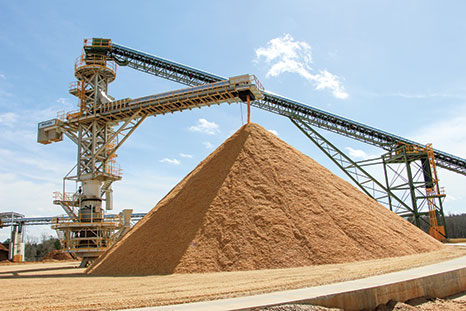Economic forecasts for paper show a weakening global demand as markets shift to e-readers, e-mails and smartphones. So when privately owned Portuguese pulp and paper giant The Navigator Co. began studying how to expand business in order to continue to enjoy expected high return on investments as well as maintain strong, sustainable profitability, the company developed a three-way plan of avenues for growth.
First, the already strong presence in owning forestland and producing pulp would be ramped up with the investment of forestland in Mozambique. Next, the existing Cacia pulp mill would be expanded to include capabilities for producing tissue paper; in addition to the purchase of a primarily tissue paper plant in Portugal.
And finally, the company created Colombo Energy Co., a wholly owned subsidiary operating in the Southern U.S. producing industrial wood pellets for European and Asian markets.
The former European Sales Director for the paper business of The Navigator Co., and now the CEO of Colombo Energy, António Porto Monteiro says the decision to move into the industrial wood pellet market was, at the time the decision was made in 2014, based on the high growth of that business, as well as on the profitability of the project, in addition to the ability to continue to be good stewards of the environment.
Furthermore, The Navigator Co. had a close relation to a pellet producer in Portugal that brought the inspiration for the project, enabling Navigator first-hand knowledge of the pellet producing business.
Porto Monteiro says Navigator’s shareholders have a very medium/long term vision for the company, and the decision that was made to start a 500,000 metric ton annual production capacity greenfield pellet project was also based on the fact that the U.S. could, and should, be a very interesting market for the company. “This experience could help the company learn the U.S. market and how to operate here, which can be used for paper or for pulp or for more pellets,” he adds.

Porto Monteiro says that while the facility was built mainly to supply industrial needs in Europe, the possibility of selling to industrial markets in Japan or even the heating domestic market, the U.S. is not being discounted. Neither is the European residential market.
Once the decision was made to begin the project, it moved quickly. Project Manager António Sequeira says the project from inception to groundbreaking took about a year. The process of choosing a location started with some internet searches, he explains, before finding information about South Carolina and its Chamber of Commerce.
Sequeira says he and his team investigated sites in forest-heavy South Carolina and Georgia primarily, but focused heavily on South Carolina—due to the warm welcome and sense that South Carolina would be able to support this type of facility. Porto Monteiro says strong support from then Governor Nikki Haley, then Lieutenant Governor Henry McMaster, and the South Carolina Chamber of Commerce was a driving force to helping bring Colombo Energy to the state.
The South Carolina Forestry Commission also had a very active industrial growth push going on and made it clear that South Carolina could support Colombo.
Sequeira says Colombo only considered places with rail access, as well as utilities. “Initially we were looking for different sites that would enable us to connect to different ports,” he adds. “We even checked into the possibility of building our own port. We did a full preengineering plan to build our own port.”
The plan to build a port was eventually scrapped, as the production cost for building a port would require several plants the size of Greenwood to sustain it—not something the first time pellet producer was interested in undertaking.